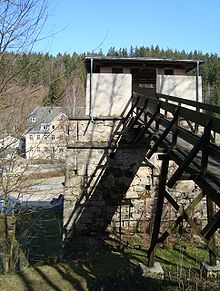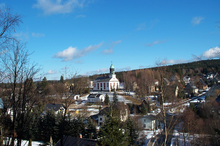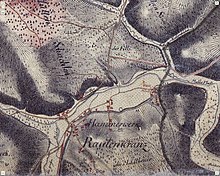Morgenröthe diamond wreath
|
Morgenröthe diamond wreath
Community Muldenhammer
|
||
|---|---|---|
| Coordinates: 50 ° 27 ′ 35 ″ N , 12 ° 29 ′ 37 ″ E | ||
| Height : | 610–974 m above sea level NN | |
| Area : | 30.03 km² | |
| Residents : | 807 (December 31, 2008) | |
| Population density : | 27 inhabitants / km² | |
| Incorporation : | October 1, 2009 | |
| Postal code : | 08262 | |
| Area code : | 037465 | |
|
Location of Morgenröthe-Rautenkranz in Saxony |
||
Morgenröthe-Rautenkranz is a district of the Saxon community of Muldenhammer in the Vogtland district and a state-approved resort in the Erzgebirge-Vogtland Nature Park .
geography
Geographical location
Morgenröthe-Rautenkranz is located northeast of Klingenthal , south of Zwickau and southwest of Aue in the ridge region of the Vogtland Ore Mountains . The district includes the places Morgenröthe and Sachsengrund in the valley of the Great Pyra and the places Rautenkranz and Muldenhammer at the confluence of the Great Pyra into the Zwickauer Mulde .
According to the natural space map of Saxony, the municipality belongs to the mesogeochore "Eibenstocker Bergrücken", the district of Morgenröthe to the microgeochore "Morgenröther valley area of the Great Pyra" and Rautenkranz partly to the microgeochore "Rautenkranz-Schönheider Mulde valley" and partly to the "Tannenbergsthaler ridge area".
Weather stations
The weather station of a weather forecast company in the Morgenröthe district is located at an altitude of 620 m above sea level. NN . It often provides extreme observation values (for example record minus temperatures at night and then relatively high daytime temperatures) because it is located in a valley. At the beginning of January 2009, the lowest temperature in Germany was measured at minus 31 degrees, at the end of January 2010 it was minus 24.6 degrees and at the beginning of January 2017 it was minus 24.2 degrees.
There is also a private weather station with a webcam, which is located at an altitude of 680 m above sea level. NN obtained data are constantly available on the Internet.
climate
Siegfried Sieber gives in his 1967 volume "The Mining Landscape of Schneeberg and Eibenstock" for the altitude 625 m above sea level. NN shows the precipitation measured between 1901 and 1950 with an average annual amount of 1072 millimeters (Leipzig 545 millimeters). The peak of the month is in July at 139 millimeters (Leipzig 78 millimeters). From the availability of these values it can be concluded that there has been a weather measuring station at this location for a long time.
coat of arms
In a silver, elliptical escutcheon with green diamond leaves, a rising sun surrounds the base of the shield , above which hovers crossed in black the miner's symbol mallet and iron . Another black fresh fork lies vertically with the prongs pointing towards the head of the shield .
history
The two districts of Morgenröthe and Rautenkranz emerged from hammer mills . The shift supervisor Elias Steiniger had a hammer mill built in 1679, which he is said to have named after the diamond wreath in the Saxon coat of arms .
At the end of December 1990 the managing director of Geophysik GmbH Leipzig, Ulrich Stötzner, gave the daily newspaper Die Welt the previously kept secret information that Morgenröthe-Rautenkranz was radioactively contaminated right down to the town center .
On October 1, 2009, Morgenröthe-Rautenkranz and the neighboring towns of Hammerbrücke and Tannenbergsthal merged to form the new community of Muldenhammer .
Dawn
The district of Morgenröthe (approx. 660 m above sea level) is the older part of the former double community on the course of the Great Pyra . The settlement was first mentioned in a document on April 8, 1618 as the tin mine "Die Morgenröthe". As recently as 1791, the area below the mouth of the Steinbächel was referred to as "the tin meadow" in the Saxon miles sheets. In that year, the owner of the mine, Georg Pflugk the Elder, Herr auf Posterstein , received the sovereign privilege to build new mine and workers' residential buildings. This represented the founding situation of the village. The place belonged to the office Voigtsberg . In 1652 Hans Hutschenreuter, at that time the owner of the tin mine, acquired the privilege of setting up a hammer mill from Elector Johann Georg I. In 1658 the work went to Caspar Wittig from Wittigsthal . In total, it changed hands ten times by 1798. This year it went to Gottlob Emanuel Lattermann, a trader from Leipzig , who entrusted his 22-year-old son, Heinrich Ludwig Lattermann , with the management of the Morgenröther hammer mill.
At the end of the 18th century, Morgenröthes districts were called Unter- and Ober-Morgenröthe.
As early as 1810, the Rautenkranzer hammer mill and a few years later, in 1835, the Tannenbergsthal hammer mill became the property of the Lattermanns.
In 1799 a new blast furnace was built in Morgenröthe, which was blown in June 1799 and which was in service until 1820. On April 30, 1819, the owners received the concession "to build a blast furnace and to set up a sheet metal rolling mill and to set up other ironworks". This furnace, built in 1820 and in operation until 1874, can still be viewed in Morgenröthe and at that time was one of the largest of its kind in Saxony. It is one of the few preserved historical blast furnaces in the new federal states . Comparable systems are only available in Schmalzgrube (preserved blast furnace from 1659), Brausenstein (preserved blast furnace from 1693), Peitz (preserved blast furnace from 1809) and Schmalkalden (new smelter) (preserved blast furnace from 1835).
One of the best-known products of the ironworks still preserved today is the Schwarzenberg blower manufactured in 1831 , a water-wheel-driven blast furnace blower designed in a neo-Gothic industrial form for the Antonshütte .
On July 24, 1879, a large part of the ironworks was destroyed in a fire, then rebuilt. From this time onwards, however, a cupola furnace was used , in which gray or bell cast iron was cast.
Morgenröthe became known for its press production (spindle and eccentric presses, also punching machines) and for the church bells of the “Schilling & Lattermann” brand, which were cast from 1918 to 1966 in this quiet side valley of the Zwickau Mulde. The Schilling bell foundry in Apolda provided the calculations , and the casting was carried out by the Lattermann company in a special alloy ( chilled cast iron - halved sound steel ) in the old casting hall. The largest bells made in Morgenröthe can be found in Riga Cathedral and All Saints Church. They were manufactured in 1926/1927, weigh 8.5 tons each, have a diameter of 2.50 m and a height of 3.00 m.
The Lattermanns were expropriated in 1946. Production continued until the factory was destroyed by a fire on November 30, 1968, but the factory was not rebuilt afterwards.
During the GDR there was a vacation home of the Deutsche Reichsbahn in Morgenröthe .
Diamond wreath
Rautenkranz was first mentioned in a document in 1679. However, it must have existed decades earlier as a small mining and hammer mill settlement. The town's founder, Elias Steiniger, borrowed the name from the diamond wreath in the coat of arms of Electoral Saxony . The name is wrongly associated with the columbine meadow rue that can be found around the place . Like Morgenröthe, the place belonged to the Voigtsberg office .
In his memories of childhood and youth in Rautenkranz, the local born Alwin Gerisch , who became chairman of the SPD in Germany after 1890, describes the life of the little people in the mountains from around 1865 onwards. Alwin-Gerisch-Strasse in the district of Rautenkranz is reminiscent of Alwin Gerisch.
Incorporations
Morgenröthe and Rautenkranz were combined into one community in 1852. In 1939, Hohehaus, Sackhaus, Muldenhammer and Sachsengrund were incorporated.
SAPD stronghold in the Weimar Republic
Morgenröthe-Rautenkranz was the only place in Germany in which the left-wing Socialist Socialist Workers' Party of Germany (SAPD) , founded in 1931, was able to achieve an absolute majority; in the local elections on November 13, 1932, she received 8 of 13 seats.
Population development
Development of the population (from 1971 December 31) :
|
|
|
- Data source from 1998: State Statistical Office Saxony
Infrastructure
The federal road 283 leads through Rautenkranz .
The Chemnitz – Adorf railway line (CA line), which runs through Rautenkranz , was opened in 1875. With the construction of the Eibenstock dam , this route was interrupted and the through traffic stopped on September 27, 1975. In the remaining section Muldenberg – Schönheide Süd (Wilzschhaus) –Schönheide Ost of the CA line, passenger traffic was discontinued in sections between 1979 and 1982 and since then only freight trains have operated until freight traffic was also discontinued in 1996. After the expansion of a switch connection in Muldenberg at the end of the 1990s, the route no longer has any connection to the rest of the DB network and is, as it were, an island route. Since 2008, a development association has been operating tourism and excursion services with a motorized trolley between Schönheide Süd and Hammerbrücke.
The place is on the long-distance cycle path Euregio Egrensis and the long-distance hiking path Eisenach – Budapest .
Culture and sights
- German space exhibition with an original MiG-21
- 4.5 m high stele in memory of the first space flight by a German cosmonaut in 1978, Sigmund Jähn, who was born in Rautenkranz
- Home parlor
- Classicist parish church, built 1838–1842
- Blast furnace of the former iron foundry
Personalities
- Dawn
- Heinrich Ludwig Lattermann (1776–1839), hammer gentleman and politician
- Hermann Lattermann (1809–1867), hammer gentleman and politician
- Carl Friedrich Zimmermann (1817–1898), inventor of the German concertina
- Gottfried Lattermann (1879–1950), hammer gentleman and dialect poet
- Diamond wreath
- Alwin Gerisch (1857–1922), chairman of the SPD and companion of August Bebel .
- Sigmund Jähn (1937–2019), spaceman / cosmonaut, first German in space.
literature
- Margarete Schattner, Karlheinz Paul, Konrad Stahl: Festschrift for the 350th anniversary of the Morgenröthe-Rautenkranz community. Municipal administration, Morgenröthe-Rautenkranz 2002. DNB 1017236178
- Dawn . In: August Schumann : Complete State, Post and Newspaper Lexicon of Saxony. 6th volume. Schumann, Zwickau 1819, p. 557 f.
- Dawn. In: The mining landscape of Schneeberg and Eibenstock (= values of the German homeland . Volume 11). 1st edition. Akademie Verlag, Berlin 1967, pp. 153–155.
- Diamond wreath. In: The eastern Vogtland (= values of the German homeland . Volume 59). 1st edition. Verlag Hermann Böhlaus Successor, Weimar 1998, ISBN 3-7400-0938-1 , pp. 190-193.
Web links
- Morgenröthe-Rautenkranz in the Digital Historical Directory of Saxony
- Morgenröthe in the Digital Historical Directory of Saxony
- Rautenkranz in the digital historical place directory of Saxony
Individual evidence
- ↑ Research map of the Landscape Research Center Dresden (LfZ) Link to the research map
- ↑ Data from the Morgenröthe weather station , accessed on December 31, 2017
- ↑ Thomas Leinkauf, Peter Riesbeck: Everyone is talking about the weather. He also. In: Berliner Zeitung . Berlin March 30, 2002 ( online [accessed January 10, 2019]).
- ↑ Online edition of the Sächsische Zeitung from January 9, 2009 ( Memento of the original from December 31, 2017 in the Internet Archive ) Info: The archive link has been inserted automatically and has not yet been checked. Please check the original and archive link according to the instructions and then remove this notice. , accessed December 31, 2017
- ↑ Focus-Online , accessed on December 31, 2017
- ↑ Report on Mdr.de ( Memento of the original dated December 31, 2017 in the Internet Archive ) Info: The archive link was inserted automatically and has not yet been checked. Please check the original and archive link according to the instructions and then remove this notice. , accessed December 31, 2017
- ^ Website of Thomas Roth's weather station: morgenroethe.no-ip.org/wetter/wetter.html
- ^ The mining landscape of Schneeberg and Eibenstock (= values of the German homeland . Volume 11). . Edition. Akademie Verlag, Berlin 1967, p. 182.
- ↑ Ernst Eichler , Hans Walther (ed.): Historisches Ortnamesbuch von Sachsen, Volume II. Berlin 2001, ISBN 3-05-003728-8 , p. 262.
- ↑ Radioactivity known in Saxony for years. Morgenröthe-Rautenkranz contaminated into the town center. In: Free Press of December 28, 1990.
- ↑ Tannenbergsthal with its districts Jägersgrün, Gottesberg and Schneckenstein. Muldenhammer municipality, accessed on December 4, 2019 .
- ↑ a b sheet 211 of the Sächsische Meilenblätter - Freiberg copy -, basic recording in 1791, supplements up to 1876 Link to the map sheet in the Dresden State and University Library
- ↑ Place directory Saxony
- ↑ Historical place directory of Saxony
- ^ Alwin Gerisch: Erzgebirgisches Volk. Memories , first published in 1918, reprinted by the SPD local association Waldgebiet-Vogtland in 2008, ISBN 978-3-00-024279-3 .
- ↑ Alwin-Gerisch-Straße in Rautenkranz at openstreetmap.org
- ^ Hanno Drechsler: The Socialist Workers' Party of Germany (SAPD). A contribution to the history of the German labor movement at the end of the Weimar Republic . Meisenheim am Glan 1965, p. 286.












